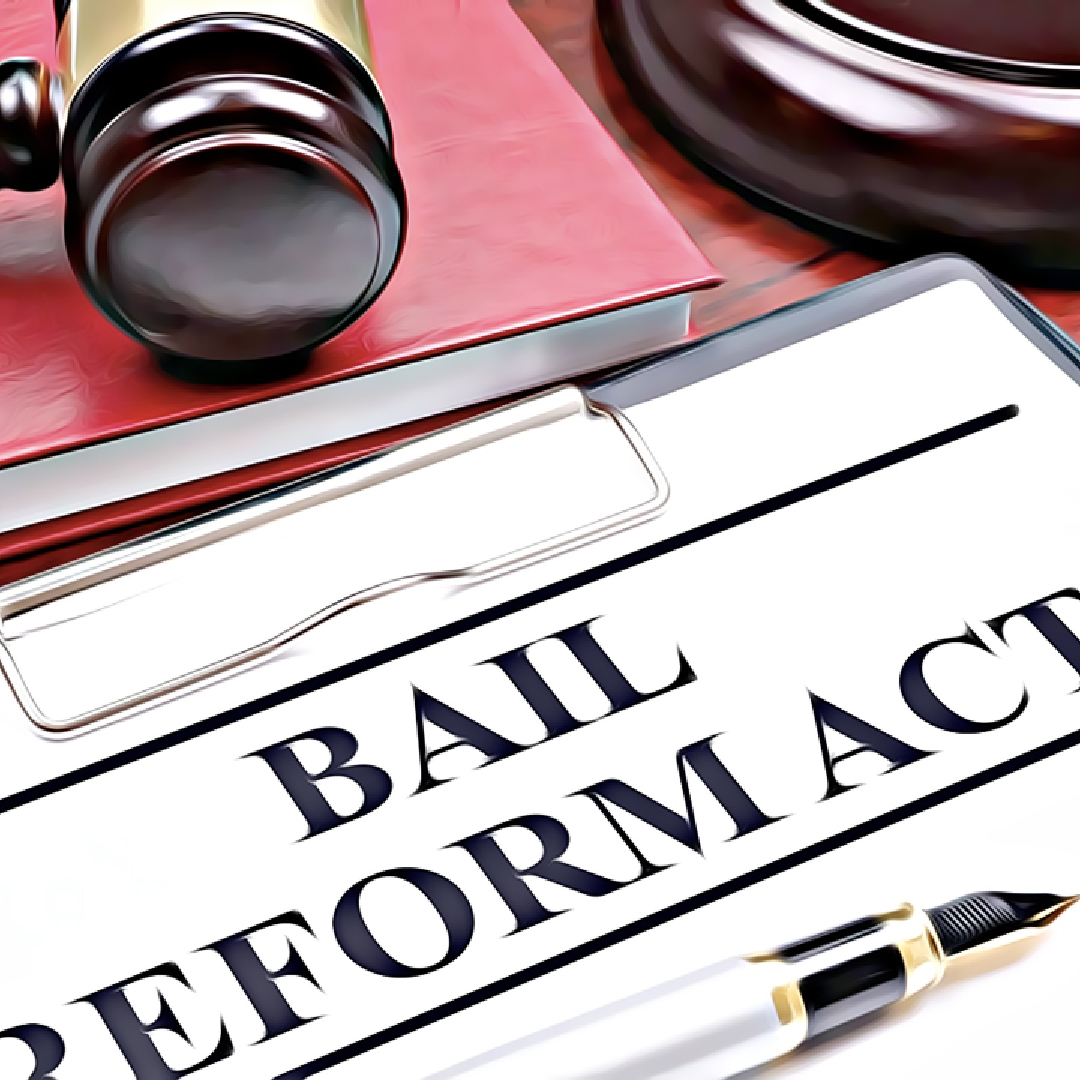New York Bail Law Explained
Bail will be available for more crimes, but the core of the law remains.
Three months after it took effect, the New York bail reform law was amended in early April, 2020. A judge can now impose cash bail in more situations than before. Additionally, bail and other pretrial release conditions will be set with increased discretion by these judges. The updates came into effect on July 1, 2020.
By reducing the number of people being held in prison awaiting trial because they could not pay bail, the original bail reform law was designed to reduce incarceration rates. A 90% reduction in cash bail would have resulted in at least 40% fewer jail inmates, according to court watchers. Other than that, judges continued to set cash bail in the remaining cases.
Before and after its implementation on January 1, 2020, the reforms of the law were criticized. A number of prominent district attorneys and other law enforcement officials have requested that the enacted law be immediately revised despite limited data. They claim that it has contributed to a rise in crime.
The legislative body complied and included the changes in the annual state budget bill, which was signed by the governor a few days later.
Despite changes to the bail reform law, the basic framework established by the original law remains unchanged. Judges are still required to release people with the least restrictive conditions necessary to reasonably assure that they will return to court for most misdemeanors and nonviolent felonies. It is still prohibited to post cash bail for these crimes.
It is generally the judge’s discretion whether to release an individual, with or without pretrial conditions that ensure the individual returns to court. Among the measures the judge can take are electronic monitoring, drug treatment programs, and setting bail. For certain felony cases, the judge may remand someone into custody.
The cash bail system expands
For most violent felonies, as well as some non-violent felonies, such as witness tampering, cash bail was offered. As a result of the revisions, a number of additional crimes and circumstances have been added to this category. Among them is the charge of second-degree burglary in which an individual is accused of entering the living area of a house, as well as certain trafficking in persons offenses and promoting an obscene sexual performance on a child. Additionally, they include certain crimes involving assault, such as vehicular assault, and all charges alleging that a person died as a result of those crimes.
Conditions trigger cash bail
In accordance with the revisions, judges will be able to set cash bail based on not only the crime committed, but also a person’s legal history and status. This will permit the use of bail in a wider range of cases than before.
If someone is on probation, under post-release supervision, or subject to sentencing as a “persistent offender,” cash bail can be set even for felony charges that would not otherwise qualify.
Moreover, cash bail may be set if a person who has been out on pretrial release for an offense involving a specific victim is arrested for a new crime that also involves a specific victim. If, for instance, a person charged with nonviolent robbery is released pretrial and commits another such robbery, a judge has the option of setting cash bail on the second arrest, despite the fact that it is not generally permitted for such crimes.
Artificial intelligence has been used to rewrite the article. We revamp articles that serve as guides, manuals, or instructional materials. The changes we have made will prevent crawlers from viewing our version as merely a copy. This initiative aims to extend the reach of important articles on police and policy.

Pretrial release options expanded
Although cash bail is now permitted in more cases, it is not required. A judge in New York is allowed to release persons pending trial under a variety of conditions designed to ensure that the person returns to court. This is even if the offense qualifies for bail.
As a result of the most recent changes, judges are now provided with more options concerning pretrial release conditions. Previously, judges could order a smaller range of measures, such as pretrial supervision and travel restrictions. Judges now have a greater degree of discretion as a result of the update. As part of their pretrial release, judges may now require individuals to surrender their passports, avoid contact with witnesses or victims, or engage in counseling or mental health treatment.
The original and revised laws do not provide sufficient funding in order to implement specific services and programs for the increased number of people who will be released before trial under supervision.
The manner in which judges can set bail still varies depending on the circumstances. As an alternative to cash bail, judges can also order a variety of bond types, such as one in which friends and family agree to guarantee a person’s return to court, and another in which property used as collateral can be forfeited if the individual fails to appear.
Collecting and analyzing data
According to the revised law, court administrators are required to collect and publish information regarding people charged with crimes and what happens during the pretrial phase of their cases. Demographical information, criminal history details, and details regarding the offenses charged are included in this data.
As part of the new law, court administrators must also keep track of how many people are released and under what conditions, how many are in pretrial custody and for how long, how often people fail to appear or are rearrested, how long any pretrial imprisonment period lasts, and how the case goes.
This information could indicate whether bail laws are working as intended if the data collection and reporting requirements are implemented rigorously. The pretrial system can also show if people are treated equally across demographic groups. Data could also tell you what conditions of pretrial release are most and least effective at getting people back to court over time.
However, no specific funding was allocated for these new requirements.
Bail reform in New York: long-term effects
The bail law changes in New York still leave cash bail in place, but the state is giving judges greater discretion in how to arrange pretrial release conditions. The revised law still does not require judges to set cash bail, even though it is now an option in more cases.
No one should be imprisoned for lack of funds. There should be a collaborative approach between the prosecutor, the defense attorney, and the judge with regard to establishing pretrial release conditions that are reasonable and do not restrict people’s freedom excessively.
The use of cash bail can be especially harmful to individuals who have not been proven guilty in a system where everyone is presumed innocent. Aside from the trauma of imprisonment, even a brief period of detention can result in loss of employment, housing, or custody of a child.
As a result, prosecutors should refrain from asking for cash bail as often as possible, and judges should rarely set it without fully assessing the defendant’s risk of flight and financial ability to pay. Considering other places that have implemented bail reform, it is likely that society as a whole will benefit greatly from fewer people being imprisoned in awaiting trial.
Bail Reform
Amendments
S.7506-B/A. 9506-B (Part UU)
Expands the list of offenses that are “qualified offenses” (bail eligible) to include, among others: any crime alleged to have caused the death of another person; criminal obstruction of breathing or blood circulation, strangulation 2nd, unlawful imprisonment 1st (all when committed against member of same family or household); assault 3rd or arson 3rd as a hate crime; a felony committed while on probation or released on supervision; a felony or class A misdemeanor involving harm to an identifiable person or property while the person is ROR’d or released under conditions on separate felony or class A misdemeanor involving harm to an identifiable person or property. Increases the list of potential conditions under which an arrestee may be released under non-monetary conditions, to include: refrain from contact with certain people; mandatory programming; obey an Order of Protection; obey other conditions set by court relating to the safety of a victim of a family offense. Requires the chief administrator of the courts, in conjunction with DCJS, to collect detailed data and report regarding pretrial release and detention.
Signed: April 3, 2020 Chapter 56 – Budget Bill: Part UU
Effective: July 2, 2020.
Amends: Multiple sections of the Criminal Procedure Law; §216 of the Judiciary Law, by adding a new subdivision 5; and Executive Law by adding a new section 873-u.
Bail-Eligible Offenses Under
New York's New Bail Laws
Aggravated assault upon a police officer or a peace officer – B violent felony, PL 120.11
Aggravated criminal contempt – D felony, PL 215.52
Aggravated Criminal Possession of a Weapon – C violent felony, PL 265.19
Aggravated criminally negligent homicide – C violent, PL 125.11
Aggravated Enterprise Corruption – A-I felony, PL 460.22
Aggravated manslaughter 1 – B violent felony, PL 125.22
Aggravated manslaughter 2 – C violent felony, PL 125.21
Aggravated murder – A-1 felony, 125.26
Aggravated sexual abuse 1 – B violent felony, 130.70
Aggravated sexual abuse 2 – C violent felony, 130.67
Aggravated sexual abuse 3 – D violent felony, 130.66
Aggravated sexual abuse 4 – E violent felony, 130.65-a
Aggravated unpermitted use of indoor pyrotechnics 1- D violent felony, 405.18
Arson 1 – A-1 felony, 150.20 Arson 2 – B violent felony, 150.15
Assault 1 – B violent felony, 120.10
Assault 2 – D violent felony, 120.05
Assault on a Judge – C violent felony, 120.09
Attempt of Class A-I of: A-I felony, 110.05, Murder-1, Aggravated Murder, Criminal Possession of a Chemical or Biological Weapon-1, Criminal Use of a Chemical or Biological Weapon-1
Attempt of Class A-I of: B violent felony, 70.02, Murder-2, Kidnapping-1, Arson-1
Attempt of a class A-II Felony A-II felony 110.05
Attempt of a class B Violent Felony C violent 70.02
Attempt of a class C Violent Felony D violent 70.02 110.05
Attempt of a class D Violent Felony of: E violent 70.02 Cr. Possession of a Weapon-3 per, PL 265.02(5),(6),(7),(8) as a lesser included offense
Burglary 1, B violent felony, 140.30
Burglary 2, C violent felony, 140.25
Conspiracy 1, A-I felony, 105.17
Course of sexual conduct against a child 1, B violent felony, 130.75
Course of sexual conduct against a child 2, D violent felony, 130.80
Crime of terrorism, See PL 490.25(2), 490.25
Criminal contempt 1, E felony, 215.51
Criminal possession of a chemical weapon or biological weapon 1, A-I felony, 490.45
Criminal possession of a chemical weapon or biological weapon 2, B violent felony, 490.40
Criminal possession of a chemical weapon or biological weapon 3, C violent felony, 490.37
Criminal possession of a weapon 1, B violent, 265.04
Criminal possession of a weapon 2, C violent, 265.03
Criminal possession of a weapon 3, D violent, 265.02(5), (6), (7), (8), (9), (10)
Criminal sale of a firearm 1, B violent felony, 265.13
Criminal sale of a firearm 2, C violent felony, 265.12
Criminal sale of a firearm 3, D violent felony, 265.11
Criminal sale of a firearm with the aid of a minor, C violent felony, 265.14
Criminal sexual act 1, B violent, 130.50
Criminal sexual act 2, D violent, 130.45
Criminal use of a chemical weapon or biological weapon 1 A-I felony, 490.55
Criminal use of a chemical weapon or biological weapon 2 A-II felony, 490.50
Criminal use of a chemical weapon or biological weapon 3 B violent felony, 490.47
Criminal use of a firearm 1 B violent felony, 265.09
Criminal use of a firearm 2 C violent felony, 265.08
Facilitating a sex offense with a controlled substance D violent felony, 130.90
Falsely reporting an incident 1 D violent felony, 240.60
Falsely reporting an incident 2 E violent felony, 240.55
Gang assault 1 B violent felony, 120.07
Gang assault 2 C violent felony, 120.06
Hate Crime See PL 485.10, 485.05
Hindering prosecution of terrorism 1 B violent felony, 490.35
Hindering prosecution of terrorism 2 C violent felony, 490.30
Incest 1 B violent felony, 255.27
Intimidating a victim or witness 1 B violent felony, 215.17
Intimidating a victim or witness 2 D victim felony, 215.16
Kidnapping 1 A-I felony, 135.25
Kidnapping 2 B violent felony, 135.20
Manslaughter 1 B violent felony, 125.20
Operating as a Major Trafficker A-1 felony, 220.77
Persistent sexual abuse E violent felony, 130.53
Predatory sexual assault A-II felony, 130.95
Predatory sexual assault against a child A-II felony, 130.96
Rape 1 B violent felony, 130.35 Rape 2 D violent felony, 130.30
Reckless assault of a child D violent felony, 120.02
Robbery 1 B violent felony, 160.15
Robbery 2 C violent felony, 160.10
Sex trafficking B felony, 230.34
Sexual abuse 1 D violent felony, 130.65
Sexually motivated felony See PL 130.92 130.91
Soliciting or providing support for an act of terrorism 1 C violent felony, 490.15
Soliciting or providing support for an act of terrorism 2 D violent felony, 490.10
Stalking 1 D violent felony, 120.60
NON-VIOLENT FELONIES:
B non-violent: Witness Tampering, PL §215.13, Facilitating Sexual Performance by a Child with a Controlled Substance or Alcohol, PL §263.30, Sexually Motivated Promoting Prostitution, §130.91/230.32, Sexually Motivated Compelling Prostitution §130.91/230.33, Aggravated Patronizing a Minor for Prostitution 2, PL §230.13, Conspiracy 2° (to commit homicide), PL §105.15, Money Laundering in Support of Terrorism 1º, §470.24
C non-violent: Use of a Child in a Sexual Performance, PL §263.05, Sexually motivated Manslaughter 2°, PL §§130.91/125.15, Sexually Motivated Robbery 3°, PL §§130.91/160.09, Sexually Motivated Promoting Prostitution 2°, §130.91/230.31, Sexually Motivated Use of a Child in a Sexual Performance, PL §§130.91/263.05, Money Laundering in Support of Terrorism 2º, §470.23
D non-violent: Witness Tampering, PL §215.12, Patronizing a person for prostitution 1°, PL §230.06, Incest 2°, PL §255.26, Aggravated Criminal Contempt, PL §215.51 (only if case is DV), Luring a Child, PL §120.70(1), Sexually Motivated Stalking 1°, PL §§130.91/120.60 (note that subdiv.1 which is violent), Sexually Motivated Burglary 3°, PL §§130.9/140.20, Sexually Motivated Robbery 3°, PL §§130.91/160.10, Sexually Motivated Disseminating Indecent Material to Minors 1°, PL §§130.91/235.22, Sexually Motivated Promoting an Obscene Sexual Performance by a Child, PL §§130.91/263.15, Sexually Motivated Promoting a Sexual Performance by a Child, PL §§130.91/263.15
E non-violent: Witness intimidation, PL §215.15 (E felony), Criminal Contempt 1°, PL §215.51 (b)(c) or (d) (if case is DV), Rape 3°, PL §130.25, Patronizing a Person for Prostitution 2°, PL §230.05, Aggravated Patronizing a Minor for Prostitution 3°, PL §230.11, Incest 3°, PL §255.25 MISDEMEANOR SEX OFFENSES: Sexual Misconduct, PL §130.20 (A misdemeanor), Forcible Touching, PL §130.52, Sexual Abuse 3, PL §130.55(B misdemeanor), Sexual Abuse 2, PL §130.60 (A misdemeanor)
OTHER MISDEMEANOR OFFENSES:
CONTRIBUTORS
“A community that populates solidarity is a community that is protected, not policed.”











